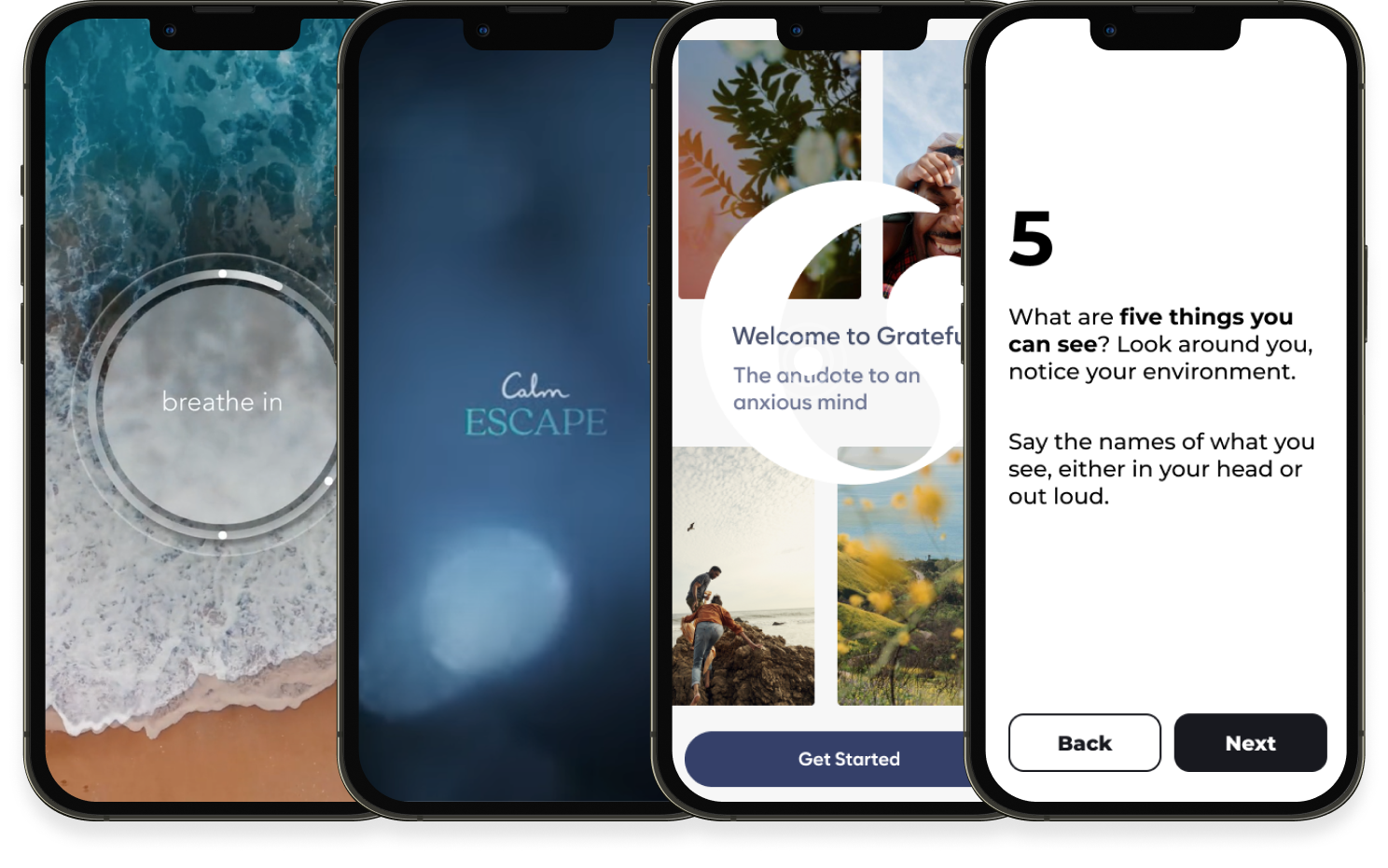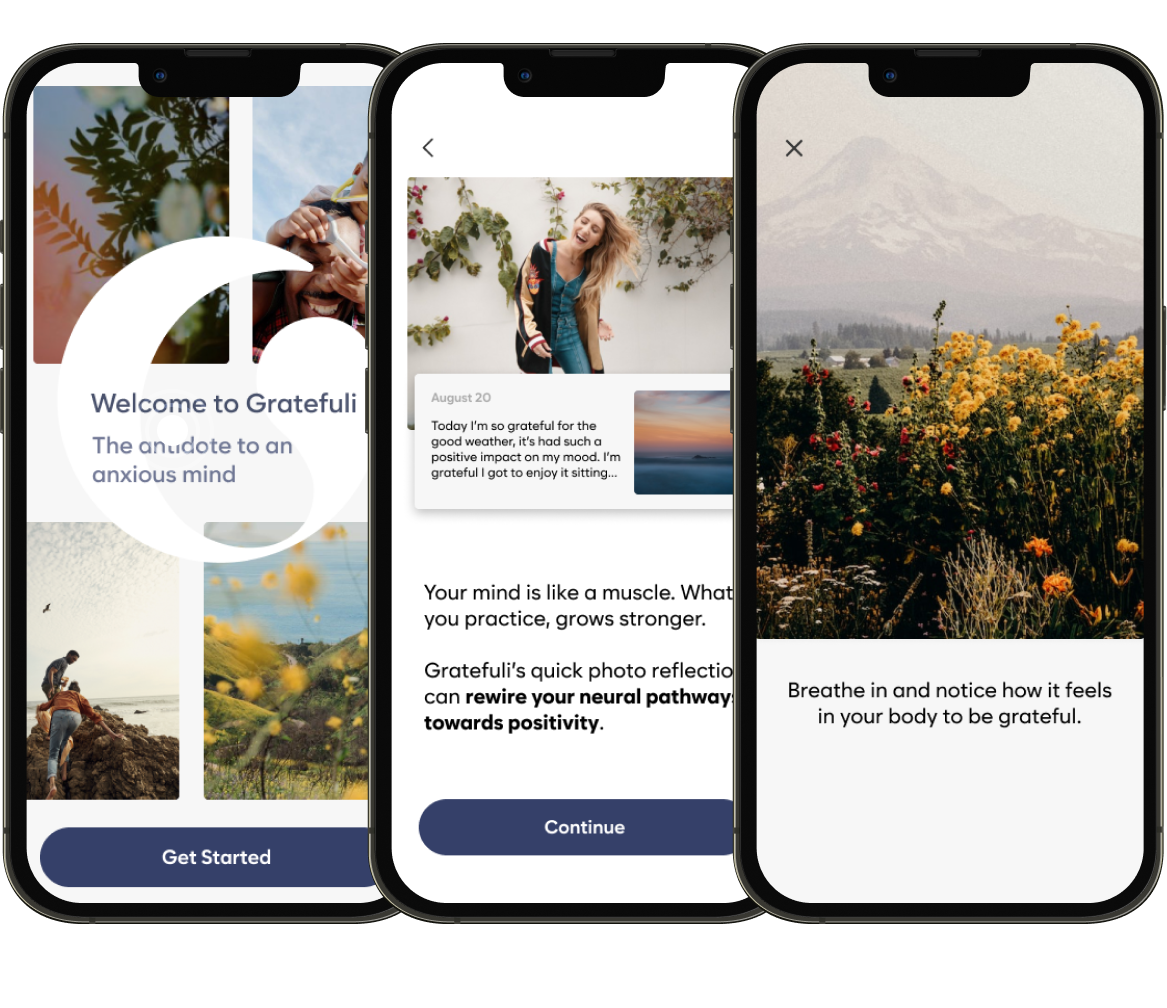Innovating Stress and Anxiety Solutions with Project Anxli
How we went from one big problem to four user-tested ideas in 4 months

🤔 Problem
🎯 Goal
🚀 Vision
🎉 Success
Our process was Understand -> Ideate -> Prototype -> Decide.
- Generative research into known, but unclear, problem
- Documented design and innovation constraints based on research
- Brainstorm sessions
- User testing to short-list concepts to prototype
- Breadboard concepts and build prototypes
- Test prototypes with users
- Decide what makes it into the app and what needs further consideration
Understand phase: Research deep dive on stress and anxiety reactionists
After Improving Sleep, Reducing Stress and Anxiety is our second largest customer goal. Because of that, we did a deep dive round of research into the user goal of reducing stress and anxiety. We wanted to get a clear understanding of what the problem was, and how people wanted to go about solving it, and conversely, what is not helpful for them (spoiler: meditation). One major finding was that we have a small amount of content and features designed for this stress and anxiety cohort specifically.
Also in that research we identified several useful design constraints we wanted to use to build solutions for this group:
✅ It is
|
❌ It isn't
|
✅ It does
|
❌ It doesn't
|
From here we went into the ideation phase, where a cross-functional group came up with dozens of concepts.
Ideate phase: Going wide with potential ideas
Using the Stress/anxiety innovation playbook we created based on research, we ran two separate brainstorming sessions: one focusing on new content opportunities, and the other specifically focused on non-content solutions.
The next step was to “get out of the building” and let real people help us understand which concepts to pursue.
Build the Anxili app: asking users to design our competition
On usertesting.com we had people build a fake competition app called “Anxli” asking them to sort different features (a combination of things from the brainstorm and product planning) based on what they thought would be best for them. In the test, Anxli was promoted as “a new app that will help millions of people around the world conquer their stress and anxiety. Unlike other apps we will not focus on difficult meditation and long term commitments.”
Users sorted the concepts into app sections and then were asked to vote for three concepts the team should build and three things the team should deprioritize. We looked at what got the most votes to build and the most inclusion on the home screen to pick our top concepts to test. The ideas that bubbled up to the top are the four concepts we’ll cover in this document.
Top concepts after voting IIMGEach user in testing voted for three concepts that the “Anxli” team should build, and three to omit.
At this point we felt we had enough data to validate the customer and problem phases of the hypothesis framework below, and were ready to test the top concepts.
✅ Customer
Who are our customers?We believe Stress/Anxiety Reactionists are motivated to remove negative feelings and uncomfortable physical symptoms when reducing stress/anxiety.
✅ Problem
Who are our customers?We believe Stress/Anxiety Reactionists are frustrated by reducing stress/anxiety because of these problems:
- Health concerns (high blood pressure, elevated heart rate, stress)
- Circumstances not conducive to solving the problem
- No reliable solution currently
- Problem severity
- Not feeling seen/heard
- Meditation is misaligned with their goal
- They want reassurance things will be OK
- They ideally want to prevent the problem
- They need guidance to solve the problem
- They want permission to invest in self-care
❓ Concept
Will this concept solve their problem?We believe that [concept] will solve the problem described above and be valuable to Stress/Anxiety Reactionists while reducing stress/anxiety. We will know this to be true when we see positive change in stress/anxiety levels in concept testing.
❓ Feature
Can they use this feature?We believe that Stress/Anxiety Reactionists will be successful solving the problem described above using [feature] while reducing stress/anxiety. We will know they were successful when we see [criteria].
Prototype phase: Building four new solutions to learn from
From here we started building prototypes. For each of the four concepts we decided to test, we built a breadboard outlining the basic user experience/flow and then a functioning prototype.
Let’s take a look at each concept below.
🍃 Immersive breathing

What is it?
Stress/anxiety reactionists need guidance and don’t want to be left in silence, so this is a much more direct and guided version of our breathwork offering. It includes a narrator (Anna Acton), who mentions helping you with stress and anxiety, a calming ocean background scene, and an animated breath bubble that follows along with the instructions. The version we tested was 3:35 in duration.
How did it perform in testing?
Overall this prototype was effective in reducing users’ stress and anxiety in the moment. Breathwork is a tried and tested method, and the additional layers of engagement we added tested positively. Many users mentioned being surprised at how well it worked, or thankful that they were randomly chosen for a test like this, because they “needed it today.” Multiple people yawned, felt sleepy or mentioned feeling hypnotized by the prototype. Here’s a participant who is almost moved to tears from the test. This concept had the highest confidence rating of the four prototypes tested.
“I honestly have to say, and I’m not just being biased right now, but that really, really calmed me down, almost like I was hypnotized in a sense. I would love to request access to the beta.”
—XCXV
| Change in stress/anxiety level (1–5 scale) | How valuable | Confidence in solution | Request access to beta |
| 1.15 + | 4.3/5 | 4.2/5 (best) | 60% yes |
Key findings
- Breathwork works, and this is a more engaging version of our current breathe bubble
- Mentioning stress and anxiety reduces cognitive load (this solution is for your problem)
- Users felt “seen” because of the narration
- The 3:35 duration tested well
🏕 Escapes

What is it?
We saw a very common pattern in the stress and anxiety research: everyone’s first step at solving the problem was trying to escape their current location and situation. People would lock themselves in the bathroom, go for a walk, get in their car, all in an attempt to escape their circumstances. But that was often conditional on where they were, and what they were doing. What if they weren’t able to physically remove themselves? This is where the idea of an Escape came in.
The Escape prototype is a five-minute audio/video adventure, where Chris Advansun narrates you through an escape into a forest where you do breathwork, observe the nature around you, and go through a stress and anxiety-reducing thought exercise.
How did it perform in testing?
Again, this prototype tested well, reducing user stress/anxiety levels by 1.25 points. It was also scored as the most valuable of the concepts tested. Confidence numbers were low because users mentioned needing to try other versions of the escape to see if it would be effective, and expressed concern about remembering to do an activity like this in a time of need.
“I definitely want to request access to beta. So it’s an app, very cool. I definitely want to check this out, that would be amazing. Hopefully it is as good as it seemed in that 5-minute video. You definitely made me feel more calm today, and gave me some hope. Hopefully this app is as amazing as the 5-minute video. I really look forward to trying it out. I can’t wait actually.” —wongathon115
| Change in stress/anxiety level (1–5 scale) | How valuable | Confidence in solution | Request access to beta |
| 1.25 + | 4.4/5 (best) | 3.8/5 (best) | 50% yes |
Key findings
- This feels like a fun, Calm approach to the problem of stress and anxiety
- Users responded well to the nature scenery, and wanted different locations to escape to
- Calming imagery helped users focus on the “meditation”
- Highest value rating of the four concepts
📸 Photo gratitude journal

What is it?
Gratitude is helpful in reducing anxiety and promoting positive thinking. Many people tested didn’t make that connection, or if they did understand the value, they weren’t currently practicing gratitude. This prototype was an app called Gratfuli that lets users create gratitude posts from their photos and share them with friends and family.
How did it perform in testing?
It did OK, but not great. One thing to consider here is that users were not using their own photos to make gratitude posts, but they all seemed to understand the concept. This concept had three of the worst scores in this round of testing: value, confidence, and access to beta.
“It’s like a gratitude journal but really quick. I’m a little skeptical, I can see in theory it would be good, but it’s kind of like another to-do. Maybe after it becomes a habit that wouldn’t be a big deal, but right now I don’t want to add another task to my list. But if it worked it would be valuable.” —SS1234
| Change in stress/anxiety level (1–5 scale) | How valuable | Confidence in solution | Request access to beta |
| N/A | 3.9/5 (worst) | 3.3/5 (worst) | 40% yes (worst) |
Key findings
- Lowest scores of the concepts tested
- Users were concerned about privacy
- Users thought this app was delightful but didn’t necessarily see themselves using it
💬 Text-based anti-stress/anxiety activities

What is it?
This prototype is simple text instructions with a back, and next button. Users complete sessions one small step at a time. This is our approach at a discrete, light-weight way to get people to do helpful activities to reduce stress and anxiety. It was also a way to capture a few of the ideas that people seemed most interested in, in a new format: guided relaxation, grounding sessions, body scans, progressive muscle relaxation, education. You can read more about this concept here in a more thorough writeup.
How did it perform in testing?
This concept tested well with users, it was short, unintimidating and easy to complete. Most importantly it was more effective in reducing stress and anxiety levels than the other three concepts, scoring slightly higher Escapes. This prototype, while basically moving wireframes, also had the highest score for beta access opt-in.
“I actually would like access to this beta app. I have tried meditation apps and I’m not a fan, but this was cool.” —PatientBush3601
| Change in stress/anxiety level (1–5 scale) | How valuable | Confidence in solution | Request access to beta |
| 1.3 + (best) | 4.2/5 | 3.5/5 | 70% yes (best) |
Key findings
- Most effective of the prototypes tested
- Highest request access to beta numbers
- Simple method to have users practice mindfulness and meditation elements
- Again, low confidence score because users said they would need help remembering to use something like this in a time of need
Decide phase
After reviewing the findings and considering opportunities, the team prioritized and developed the "Text-based activities" concept, which was later rebranded to simply "Taptivities." It was the first new content type introduced to the app in years, and tested well with customers when launched. This was a tipping point for the Calm design, product and content teams, as seeing the customer response to a non-audio (and exterroceptive mindfulness method) led to a creation of a suite of new mindfulness activities that users love.